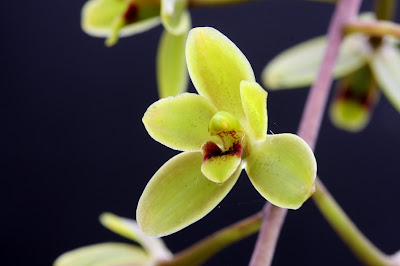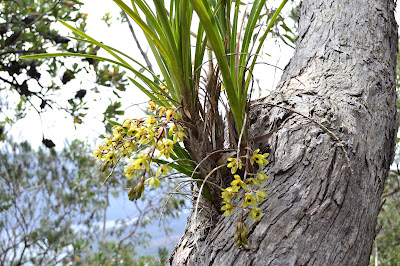Cymbidium suave - Snake orchid - Grassy boat-lip orchid is found growing on large old trees with decaying heartwood in moist forests and woodlands..
Cymbidium suave also called as Snake orchid, Grassy boat-lip orchid, Cymbidium gomphocarpum, is a species of the genus Cymbidium. This species was described by Robert Brown in 1810.
IDENTIFY CYMBIDIUM SUAVE - SNAKE ORCHID - GRASSY BOAT-LIP ORCHID
Cymbidium suave is native to New South Wales, Queensland. It is found growing on large old trees with decaying heartwood, where the grassy clumps protrude from hollows and cracks within tree trunks in moist forests and woodlands at elevations of 0-1350 meters above sea level.
Snake orchid is a large to giant sized, hot to cool growing epiphyte with narrow, erect, without pseudobulbs, 30-50 cm x 1.5-2 cm stem that covered with imbricate fibrous leaf bases. The leaves are 4-8, erect to pendulous, scattered along pseudobulb, distichous, alternate, sessile, base sheating stem; lamina linear to lorate, 30-45 cm x 1.5-2 cm, dark green, thin-textured, flat, apex acute.
Grassy boat-lip orchid blooms in late winter though early summer from the axillary raceme, arching to pendulous, 10-30 cm long, 5-50 flowered inflorescence that borne in the axils of bases of fallen leaves. The flowers are 23-35 mm x 20-30 mm, sweetly fragrant; sepals and lateral petals usually olive green; labellum 9.5–11 mm long with 1 indistinct keel from the base to the base of the midlobe, in front of which is a shallow depression, yellow to green with a conspicuous dark brown stripe on the disc.
CYMBIDIUM SUAVE - SNAKE ORCHID - GRASSY BOAT-LIP ORCHID CARE AND CULTURE
Cultural information should only be used as a guide, and should be to be adapted to suit you. Your physical location; where you grow your plants, how much time you have to devote to their care, and many other factors, will need to be taken into account. Only then can you decide on the cultural methods that best suit you and your plants.
Light:
Cymbidium suave needs the light level of 27000 - 43000 lux during the early growth, this may require 50% shading especially in summer months. Regular growth light level should be at 43000 - 54000 lux (30% shading during summer). At flowering light levels should be at 20000 - 30000 lux. In cool areas or in winter months, full sun is tolerated.
Watch the color of the leaves; foliage should be yellowish-green in color, but too much light will result in a pale yellow color and if burned, a black spot at the arch of the leaf. If severely burned, the leaf will be bleached white. If too shady, plants will be dark, lush green but will bloom less or not at all.
Temperature:
Snake orchid needs day temperatures of 25-28°C and night temperatures of 15-18°C. It is very important for initiation of spikes to have a difference in temperatures between night and day. This can be achieved in the summer by sprinkling the leaves in the late afternoon or early evening for evaporative cooling.
Humidity:
Grassy boat-lip orchid needs the humidity levels of 40 - 60% most of the time, however they can tolerate humidity levels of 60 - 80% in times of high light which will help to also reduce temperature levels. Humidity should also be reduced to 40 - 60% at flowering.
Good air circulation is essential for good plant growth, supplying oxygen and carbon dioxide and promoting the quick drying off of leaves thus preventing fungal, bacterial and red spider problems. The air surrounding the plant must be moist. Bad ventilation causes poor growth and immature buds to yellow and drop off.
Substrate, growing media and repotting:
Cymbidium suave are usually grown in pots or containers with excellent drainage, filled with loose, quickly drying substrate, so that the plants can be watered frequently and the substrate is kept dry. Most growers use a mixture based on tree fern bark or chopped fibers. Different amounts of chopped sphagnum moss, osmunda fern roots, sand, perlite, charcoal and fibrous clay are also usually added; many growers use fine to medium bark without additives. Medium granulation bark in the lower half of the pot and in the upper part, fine bark with the addition of about 10% perlite and 10% charcoal works perfectly well.
The plant should be repotted only if the pot is overcrowded which happens on average every two or three years or when the medium has broken down, for the plant thrive best when left undisturbed. Repotting should be carried out during spring (after flowering). During repotting dead or withered roots should be removed. Older roots should be trimmed up to 10-15 cm from the base of the bulbs; Leave the root tissue to air dry. Always sterilize cutting tools between plants.
If you decide to divide the plant, look for natural divisions which allow three to five-bulb groupings. If the dormant bulbs (back bulbs) can be removed without destroying the strength of the division, remove them. These can be potted up to resprout and bloom in two to four years.
Watering:
Snake orchid should be watered abundantly during active growth, but there should be excellent drainage and the substrate around the roots should never be soggy or stale. Water more frequently in periods of dry heat and winds and less in cold, wet weather. When the new growths reach maturity in autumn, the amount of water should be gradually reduced.
The plant love overhead watering during summer and early autumn, but never in the middle of the day on hot days or the leaves will burn and you may cause rot. It is best to overhead water late in the afternoon or early evening when the sun has gone from the plants. Such watering washes dust and dirt from the leaves and allows the plant to take in moisture through the leaves. Do not overhead water or mist in cold or wet winter weather. Water early in the morning in winter so plants can dry out. In winter it is better to under rather than over water.
Fertilizer:
When the plants are actively growing, from September through to mid December, they must have an NPK fertiliser high in nitrogen to stimulate growth. From mid December, when flower spikes initiate, flowering should be encouraged by the use of a fertiliser high in phosphorous and potash. These assist in the formation of flower spikes, ensuring that the flowers will be bigger and stronger and firm up the leaves thus avoiding soft growth. Fortnightly fertilizing using half recommended strength is advisable. You may prefer to fertilize at quarter strength every week. It is important to always give the plants a good watering before fertilizing, otherwise the roots will burn.
To avoid mineral deposits building up during periods of heavy fertilization, it is advisable to rinse the containers approximately every month. Rinsing is especially important where the water is highly mineralized. First, water the plant normally to dissolve the accumulated salts, and after about an hour, rinse the substrate with water equal to twice the volume of the container.
Rest period:
Grassy boat-lip orchid should be limited in the amount of water during 2-3 winter months. They should dry up a bit between waterings, but they must not be left without water for too long. Fertilization should be reduced or eliminated until new growths appear in spring, at which point regular watering resumes.
BUY CYMBIDIUM SUAVE - SNAKE ORCHID - GRASSY BOAT-LIP ORCHID AND RELATED PRODUCTS
BUY ANOTHERS SPECIES AND VARIETIES OF CYMBIDIUM ORCHID GENUS HERE!















COMMENTS